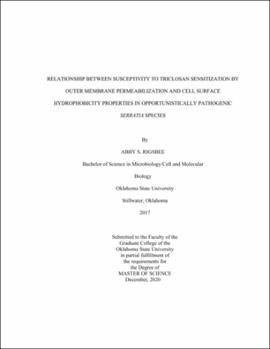| dc.contributor.advisor | Champlin, Franklin R. | |
| dc.contributor.author | Rigsbee, Abby S. | |
| dc.date.accessioned | 2021-05-25T20:42:27Z | |
| dc.date.available | 2021-05-25T20:42:27Z | |
| dc.date.issued | 2020-12 | |
| dc.identifier.uri | https://hdl.handle.net/11244/329975 | |
| dc.description.abstract | The nosocomial opportunists Pseudomonas aeruginosa and Serratia marcescens are atypically resistant to the hydrophobic biocide triclosan due largely to outer membrane impermeability properties for hydrophobic substances. However, we have recently shown that the degree of cell envelope exclusivity differs among other opportunistically pathogenic Serratia species. Moreover, susceptivity to sensitization to triclosan by outer membrane permeabilization also differs among other intrinsically resistant species. The purpose of the present study was to determine if cell surface hydrophobicity (CSH) properties underlie susceptivity to triclosan sensitization by outer membrane permeabilization in selected species. Three Serratia species (marcescens, fonticola, and odorifera) exhibiting disparate degrees of intrinsic susceptibility to hydrophobic antibacterial agents and susceptivity to triclosan sensitization by outer membrane permeabilization were examined to determine their ability to associate with hydrophobic substances. CSH was determined using conventional crystal violet binding, hydrocarbon adherence, and n-phenylnapthylamine uptake methods. S. marcescens and S. fonticola were intrinsically resistant to hydrophobic antibacterial agents including triclosan, while S. odorifera was susceptible. Their cell surface hydrophobicity properties differed only slightly regardless of disparate susceptivity to triclosan sensitization. These data suggest that phenotypic differences seen in three opportunistic Serratia species with regard to intrinsic resistance to triclosan are in at least part due to disparate outer membrane exclusion potential. Moreover, susceptivity to triclosan sensitization by outer membrane permeabilization appears not to be influenced by cell surface hydrophobicity properties. | |
| dc.format | application/pdf | |
| dc.language | en_US | |
| dc.rights | Copyright is held by the author who has granted the Oklahoma State University Library the non-exclusive right to share this material in its institutional repository. Contact Digital Library Services at lib-dls@okstate.edu or 405-744-9161 for the permission policy on the use, reproduction or distribution of this material. | |
| dc.title | Relationship between susceptivity to triclosan sensitization by outer membrane permeabilization and cell surface hydrophobicity properties in opportunistically pathogenic Serratia species | |
| dc.contributor.committeeMember | Curtis, Kathleen S. | |
| dc.contributor.committeeMember | Kohler, Gerwald A. | |
| dc.contributor.committeeMember | Katz Amburn, Diana S. | |
| osu.filename | Rigsbee_okstate_0664M_16977.pdf | |
| osu.accesstype | Open Access | |
| dc.type.genre | Thesis | |
| dc.type.material | Text | |
| dc.subject.keywords | cell surface hydrophobicity | |
| dc.subject.keywords | outer membrane permeability | |
| dc.subject.keywords | serratia | |
| dc.subject.keywords | triclosan | |
| dc.subject.keywords | triclosan sensitization | |
| thesis.degree.discipline | Biomedical Sciences | |
| thesis.degree.grantor | Oklahoma State University | |
